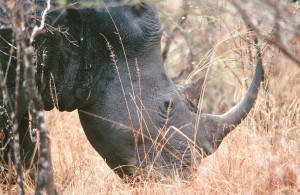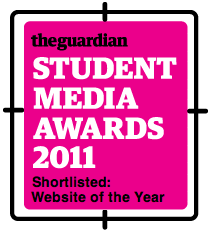
To the Point: Rhinoceros horns are extremely valuable on both the legal and illegal markets. Photo from the World Resources Institute.
Rhino horn is more expensive than cocaine or gold on the Asian market, where it is worth over US$65,000 (£41,000) per kilogram. The horns are composed of keratin, the same substance as is found in human finger nails, but are seen to hold important Chinese medicinal values.
The rhino has survived for tens of millions of years, but is under serious threat from a new obstacle; man. A record 440 rhinos were poached in South Africa alone last year, according to the International Rhino Foundation, an increase of 97% from just five years ago, begging the question: how can poaching be controlled?
A 96% decrease in Black rhino numbers from 1970 to 1992 saw the species drop into the critically endangered bracket. In 2012, an estimated 4,240 Black rhinos survive, though the White Rhino is still at a more comfortable 20,000. Control of poaching has been successful on the whole since 1992, but a new era is emerging where black rhinos are threatened in countries like Kenya, Tanzania and South Africa.
Rhino horn is ground down into a powder and used to treat a number of illnesses. In 2003 a rumour was first circulated about the horn-aided curing of a Vietnamese official suffering from cancer accompanied a boom in the Vietnamese rhino horn market. Brian Van Blerk, a professional hunter born in Zimbabwe, says, “The reasons why poaching has become so prolific the past few years is supply and demand.” Chinese, Vietnamese and Yemeni markets are driving poachers to use more sophisticated and destructive methods of hunting, and with more than 8 million Chinese now working in Africa, the market is domestic as well as international.
Prosecuting Poachers
With this kind of monetary incentive, poaching has not only become large-scale, but also a serious professional criminal activity. A poaching network in Kenya dominated by Somalis has been linked to the wider East African Al-Shabaab cell, a splinter cell of Al-Qaeda. Helicopters, tranquilisers and silenced guns are part of this network of poachers. It is thought that piracy and poaching both stem from the same source.
Like pirates, poachers are rarely aptly prosecuted. After a rhino was poached in the Northern Kenyan Mugie Ranch, four Somalis and one Kenyan of the Picot tribe were caught in a car with two horns and were suspected of rhino poaching. They were fined only 50,000 Kenyan shillings each, the rough equivalent of US$602 (£380). Mugie has since moved its rhino into a national park. Thomas Mortensen, who lives at Mugie, admits, “With the current rate of poaching on the ranch at 1 to 2 per year, and the birth rate at 1.5 per year, you are going to lose out eventually.” Poachers can be legally shot on sight, but the law does not have the structural safeguards by which to treat them justly.
Kenyan-born Adam Clements, who runs the hunting company Adam Clements Safari Trackers, described Kenya’s wildlife conservation policy as “an animal genocide”. He argues that hunting would increase the monetary value of rhinos, and increase incentive for their safe-keeping. By providing infrastructural aid to local communities such as clinics, schools and boreholes, hunting outfitters, allowing people living in areas where rhinos are at risk to be “taught the value of wildlife”.
Killing Demand
Hunting through a permit system is legal in Tanzania and South Africa, but not Kenya. The statistics, however, don’t back up the pro-hunting argument, with so many rhinos poached in South Africa. As one Professional hunter puts it: “Most of the monies derived from hunting go to other government agencies instead of to the parks and wildlife.”
Rhino farming provides another option. Claus Mortensen advocates this as a necessary short-term policy: “If we do not start meeting the demand, we will not have any (black) rhino by 2017.” Rhino grows at roughly the same rate as human finger nails and could be shaved and the shavings used to satisfy market demand. This could compromise the competitive advantage of some rhinos, especially females who need sharp horns to protect their newly born calves. But Mr Mortensen recognises the need for rhino farming to “buy time to educate the next generations.”
Dispelling the myth about the medicinal value of rhino horns is in progress. Chinese journalists have actually visited Mugie ranch to gain information for a campaign against the use of rhino horn and other poached animal parts. Avaaz, an international charity, is rallying to encourage the EU to enforce bans on the import of horns to China and Vietnam.
Fighting poaching through conservation is effective with enough money. Action taken by the International Rhino Foundation in Loveld, South Africa, has considerably reduced poaching from 71 rhinos in 2008 to 18 in 2010. Anti-poaching requires painstaking work and puts those involved in danger. Rangers are working against the odds because, as Van Blerk says, “The areas the anti-poaching units have to cover are so vast.” In some private rhino sanctuaries, informers are said to be planted in local communities to alert the ranch-owners of a potential poach. Insufficient funds, according to Van Blerk, are the handmaidens of preservation failure.
This anachronistic obsession with rhino horns is untenable, or needs to be made so. Satisfying demand and education are the most important areas in addressing the problem. In the short term demand must be satisfied through farming rhino horns, or selling current stocks. In the long term demand can be reduced to a minimum through educating against this unsupported theory. It is humbling and shameful to think how small a speck human history is compared to the enduring rhinoceros. They are not possessions, and as Claus Mortensen says, “they belong to the world.”



